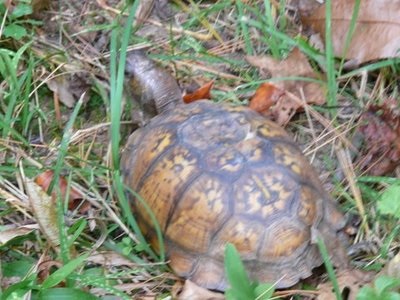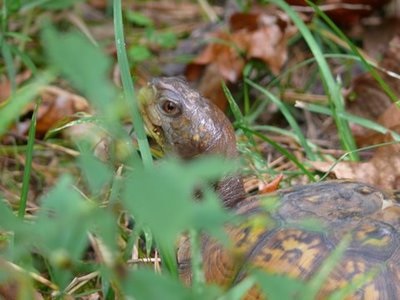Thanks to one of our volunteers, a beautiful female Box Turtle returned home this past Saturday after over a year of forced relocation. I can only believe that she was relieved and happy to be home again after such a long journey.
Her journey started over a year ago when she was crossing the road – probably on her way to lay eggs. She was run over by a car and left for dead in the middle of the road with a significant wound to the carapace (top shell). A good Samaritan that was vacationing in Kentucky from her Illinois home rescued her from the road and brought her back to Illinois.
The good Samaritan tried to care for the turtle but couldn’t get the turtle to eat and, worried that she would die, brought the turtle to a veterinarian. The veterinarian referred her to Flint Creek Wildlife Rehabilitation.
The good Samaritan, in her effort to force the turtle to eat, had aspirated her (aspiration is when food, water or other foreign body gets into the trachea or lungs, leading to respiratory compromise, pneumonia and often death). After a course of antibiotics, however, her breathing improved.
Her shell damage repaired and healthy in every other regard, it was time to return this beautiful turtle to the wild. We started networking with our volunteers and, within hours, Demayne responded that she would be leaving for North Carolina in two days and could pass through Kentucky en route.
Complete with habitat information, dietary information, turtle food for the road and our beloved turtle, Demayne left for Kentucky. Below is an excerpt of Demayne’s update regarding the release…
“Turtle had a fine journey. Sat morning she ate 2 medium earthworms and then we hit the road. Attached are pics of her release….away from the highway and incredibly forested, with good understory. She was very alert when we left her.”
See Demayne’s pictures below. Thanks, Demayne, for bringing this girl home.



Below is information regarding Box Turtles (excerpts from the Davidson College Herpetology Lab website)…..
Box Turtles are the most common terrestrial turtle in the eastern United States. They are small to medium sized turtles, attaining a maximum length of about 8 inches and having a highly domed carapace. A key characteristic of box turtles is their hinged plastron (bottom of the shell) that can be shut completely to exclude predators. Although mud, musk, and blandings turtles also posses hinged shells, they cannot be closed completely. Superficially, box turtles resemble tortoises but they are actually more closely related to many aquatic turtles and belong to the same family as spotted, bog, chicken, map, and painted turtles, as well as sliders, cooters, and diamondback terrapins. Box turtles in the United States are divided into two species, the eastern box turtle (Terrapene carolina), which ranges from Texas throughout the southeast and north to Michigan and southern Massachusetts, and the western box turtle (Terrapene ornata), which ranges west of the Mississippi to Colorado and New Mexico. The western box turtle is superficially similar to the eastern box turtle but is typically smaller and has a shell marked with radiating yellow lines. There are an additional two species of box turtle that are endemic to restricted habitats in Mexico. One of these species (Terrapene coahuila) is almost totally aquatic.Eastern box turtles are highly variable in shell shape, pattern, and coloration. Based on these differences, four subspecies of eastern box turtles have been designated. The most widespread subspecies is simply known as the eastern box turtle (T. carolina carolina). This turtle ranges along the entire east coast of the United States from Massachusetts to northern Florida, as far west as the Mississippi River, and north to the Great Lakes. Although this subspecies is highly variable in coloration, it is often more brightly colored than the other subspecies and almost always has four claws on the hind feet.
Sexing Box Turtles
As previously stated, eastern box turtles exhibit high amounts of variation in appearance. Because of this, sexing turtles can often prove difficult, especially to someone unfamiliar with box turtles. Despite these difficulties, though, there are several characteristics that can often be used to correctly determine the sex of a box turtle. Probably the two most reliable features used to sex box turtles are shell shape and tail length. Males generally have longer and wider tails than females as well as more flattened shells.
Two other features useful in sexing box turtles are eye color and plastron (bottom of the shell) concavity. In general male box turtles have very orange or red eyes and a slightly concave plastron while females have brown or light orange eyes and a plastron that is almost completely flat.
Habitat Preferences
Eastern box turtles are amazingly versatile animals and inhabit a wide variety of habitats from wooded swamps to dry, grassy fields. Although these turtles can live in a variety of different habitats, they are most abundant and healthy in moist forested areas with plenty of underbrush. Although not aquatic, box turtles will often venture into shallow water at the edge of ponds or streams or in puddles. Box turtles do not travel far, usually living within an area less than 200m in diameter. In cold climates they hibernate through the winter in loose soil at a depth of up to two feet.
Food Preferences
Box turtles are omnivores in the broadest sense of the word. They will eat almost anything, animal or plant, that they can fit in their mouth. Intriguingly, it is thought that young box turtles are primarily carnivorous and that as they grow their diet shifts more and more towards plant material. Favorite foods include almost any insect (although they seem to particularly relish worms and slugs), virtually any fruit or berry, mushrooms, a variety of vegetable matter, and even carrion. Interestingly, box turtles are even able to eat many mushrooms that are toxic to humans.
Box Turtle Life History
Box Turtles are some of the longest lived and slowest reproducing species in the world. When a box turtle first hatches from its egg it is a mere 1.25 inches long. Little is known about the lives of young box turtles because they are so secretive and hard to find. In fact, it is very rare to find a box turtle much smaller than about 3.5 or 4 inches long. It is thought that these young turtles spend most of their time concealed in brush and leaf litter and feed primarily on insects. Box turtles generally grow slowly, reaching sexual maturity at between 7 and 10 years old and 5 or 6 inches in length. Once mature, a female box turtle will lay between 3 and 6 eggs each spring in a shallow nest. The eggs are left unguarded and hatch in the late summer or early fall when hatching occurs. Box turtles commonly reach 25-30 years of age and there are well-documented cases of them living to 40 or even 50 years. Although questionable, some sources even report box turtles topping 100 years of age.
